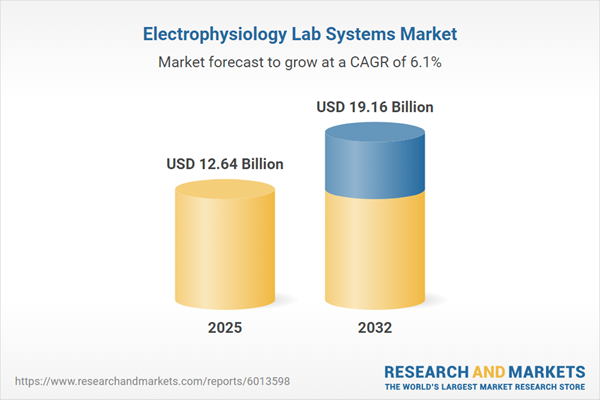Speak directly to the analyst to clarify any post sales queries you may have.
The electrophysiology lab systems market is rapidly evolving as healthcare organizations prioritize new efficiency and safety standards, respond to shifting regulatory demands, and address increasingly complex cardiac care needs. Senior decision-makers face critical choices about technology adoption and strategy that directly impact patient outcomes and operational effectiveness.
Market Snapshot: Electrophysiology Lab Systems Market Size and Growth
The global electrophysiology lab systems market is projected to expand from USD 11.92 billion in 2024 to USD 12.64 billion in 2025, and is expected to reach USD 19.16 billion by 2032, reflecting a compound annual growth rate (CAGR) of 6.10%. This sector’s growth momentum is fueled by ongoing improvements in cardiac intervention results, workflow enhancements, and scalable digital infrastructure. Heightened investment in clinical research and digitalization continues to elevate care standards and shape best practices across the industry.
Scope & Segmentation of the Electrophysiology Lab Systems Market
This report supports executives responsible for procurement, investment, and enterprise growth as they navigate an increasingly varied technology environment. In today’s dynamic landscape, actionable market intelligence underpins decisions related to procurement and innovation. Key areas of segmentation structure the market for strategic clarity:
- Technology: Solutions in this market integrate ablation and diagnostic catheter systems and employ diverse energy sources including cryoablation, radiofrequency, and laser to manage targeted arrhythmias. Advanced mapping capabilities, featuring magnetic navigation, robotic support, electroanatomical mapping, and ultrasound, enhance procedural accuracy and control.
- Product Type: The market features a combination of disposable and reusable devices to serve various healthcare environments. Complementary services, such as clinical consulting, digital visualization, system maintenance, and training, support data analysis and optimize workflows.
- End User: Electrophysiology lab systems are operating in hospitals, cardiac centers, outpatient clinics, and ambulatory surgery settings. Each end user segment has unique workflow and clinical priorities, influencing solution requirements and adoption strategies.
- Application: Equipment supports both diagnostic and therapeutic purposes, addressing arrhythmic conditions ranging from standard to highly complex presentations such as atrial fibrillation and tachycardia.
- Region: Market strategies and procurement processes differ by geography. The Americas, Europe, Middle East & Africa, and Asia-Pacific regions show unique buying behaviors, compliance expectations, and competitive dynamics that shape local and global opportunities.
- Company Coverage: Leading global companies such as Biosense Webster, Abbott Laboratories, Boston Scientific Corporation, Medtronic, Philips, GE HealthCare, Siemens Healthineers, Biotronik, Nihon Kohden, and Acutus Medical drive sector advancements through integration strategies and strategic partnerships. This influences the pace of technological adoption and innovation.
Key Takeaways for Market Leaders
- Electrophysiology lab systems are increasingly standardizing clinical procedures, enabling care teams to address a broader spectrum of cardiac conditions effectively and consistently.
- Innovations in mapping and imaging, including higher electrode density and superior visualization, are driving personalized treatment pathways and heightened diagnostic reliability.
- Collaborative approaches between vendors, consultants, and healthcare providers are shortening deployment periods and inspiring the evolution of efficient workflow models.
- Regional collaboration within manufacturing and distribution networks is reinforcing supply chain stability and strengthening organizations’ capacity to adapt to international trade variations.
- The development and provision of modular and bundled solutions allow healthcare facilities the flexibility to customize systems, ensuring alignment with both clinical demands and cost structures.
- Access to real-time analytics and continuous monitoring enables rapid organizational adaptation as clinical requirements and marketplace trends change.
Tariff Impact on Electrophysiology Lab Equipment and Supply Chains
Recent tariff increases on imported U.S. medical devices have elevated acquisition expenses, resulting in organizations renegotiating with suppliers and investing in relationships with local vendors. Emphasizing regionally based production is reinforcing supply continuity, particularly under evolving international trade agreements.
Methodology & Data Sources
This analysis is based on direct interviews with industry stakeholders, comprehensive field data, and regulatory reviews. The inclusion of clinical trial outcomes, peer-reviewed literature, and independent validation delivers robust segmentation and guidance tailored for senior clinical and operational leaders.
Why This Report Matters
- Offers executives focused insights that directly inform procurement, capital allocation, and enterprise strategies, enhancing decision-making confidence.
- Highlights how emerging technologies and regulatory change influence organizational competitiveness and strategic options in cardiac care.
- Supports benchmarking and agile adaptation as business models shift in response to regulatory and commercial pressures.
Conclusion
Utilizing this report, organizations gain solution-oriented analysis and market perspectives essential for effective decision-making, fostering innovation and adaptive growth in the evolving electrophysiology lab systems market.
Additional Product Information:
- Purchase of this report includes 1 year online access with quarterly updates.
- This report can be updated on request. Please contact our Customer Experience team using the Ask a Question widget on our website.
Table of Contents
3. Executive Summary
4. Market Overview
7. Cumulative Impact of Artificial Intelligence 2025
Companies Mentioned
The companies profiled in this Electrophysiology Lab Systems market report include:- Biosense Webster, Inc.
- Abbott Laboratories
- Boston Scientific Corporation
- Medtronic PLC
- Koninklijke Philips N.V.
- GE HealthCare Technologies Inc.
- Siemens Healthineers AG
- Biotronik SE & Co. KG
- Nihon Kohden Corporation
- Acutus Medical, Inc.
Table Information
| Report Attribute | Details |
|---|---|
| No. of Pages | 183 |
| Published | November 2025 |
| Forecast Period | 2025 - 2032 |
| Estimated Market Value ( USD | $ 12.64 Billion |
| Forecasted Market Value ( USD | $ 19.16 Billion |
| Compound Annual Growth Rate | 6.1% |
| Regions Covered | Global |
| No. of Companies Mentioned | 11 |









